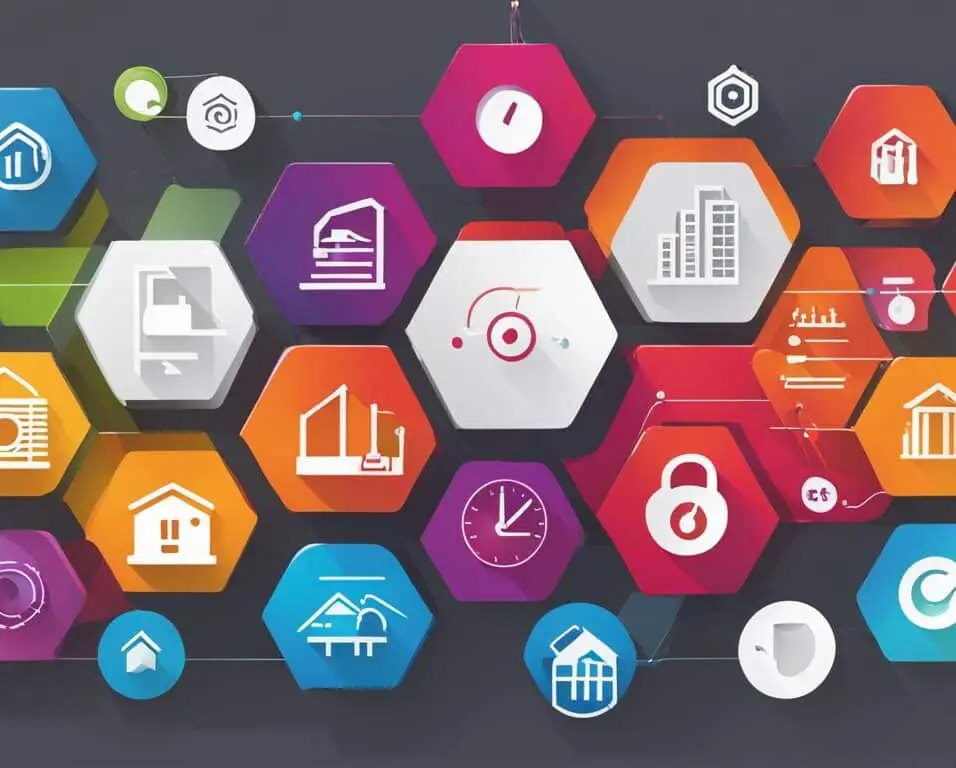The Impact of IoT on Home Automation
In today’s digital age, the Internet of Things (IoT) has transformed the way we live, work, and interact with our surroundings. One area where IoT has made a significant impact is in home automation. By integrating IoT devices into our homes, we can enjoy efficient smart home solutions that simplify our lives and enhance our living spaces.
Home automation systems that incorporate IoT technology allow us to automate various tasks within our homes, such as heating and cooling, pet feeding, and appliance control. These devices can be connected to a single network, enabling us to control and manage them remotely through our smartphones or other devices. This level of integration and connectivity brings numerous benefits to our smart homes.
One of the key advantages of IoT in smart home automation is enhanced security. By connecting devices and implementing security features, IoT technology helps protect our homes from cyberattacks and unauthorized access. It provides peace of mind, knowing that we can monitor and control our security systems even when we’re away.
Another benefit of IoT in smart homes is the simplification of tasks. With easy installation, integration, and compatibility with various platforms, IoT devices make it easier than ever to manage our smart homes. From adjusting the temperature to dimming the lights, these devices offer seamless control and streamline our daily routines.
Lastly, IoT technology improves connectivity within our smart homes. By adhering to common standards and protocols, IoT devices can work together seamlessly, enabling us to create a comprehensive ecosystem that caters to our needs. Whether it’s through Wi-Fi, Bluetooth, or mesh networks, these devices enhance our connectivity and ensure efficient communication.
As we delve deeper into the world of IoT-enabled smart homes, it is crucial to consider the security aspects and implement measures to protect our privacy and sensitive information. Likewise, integrating IoT devices with standardized protocols and ensuring compatibility will create a connected home that offers unparalleled convenience and efficiency.
- The IoT has revolutionized home automation, allowing us to automate tasks and improve our daily lives.
- IoT in smart homes enhances security, simplifies tasks, and improves connectivity.
- Securing IoT-enabled devices and adhering to standardized protocols is crucial for protecting our privacy.
- IoT devices offer easy installation, integration, and compatibility, making smart home management effortless.
- IoT technology supports multiple communication technologies, including Wi-Fi, Bluetooth, and mesh networks.
Benefits of IoT in Smart Home Automation
Smart home automation has witnessed significant advancements with the integration of IoT technology. IoT in smart home automation brings numerous benefits that enhance security, simplify tasks, and improve connectivity. Let’s explore these benefits in detail:
Enhanced Security
IoT-enabled smart home automation ensures enhanced security by connecting devices and implementing advanced security features. By integrating IoT devices, homeowners can remotely monitor and control their homes, reducing the risk of break-ins and unauthorized access. Additionally, IoT devices can detect and alert users about potential security breaches, providing peace of mind.
Simplified Tasks
One of the key advantages of IoT in smart home automation is the simplified execution of daily tasks. IoT devices offer easy installation, seamless integration, and compatibility with various platforms. This allows users to control multiple devices from a single centralized interface, simplifying daily operations and saving valuable time and effort.
Improved Connectivity
IoT follows standardized protocols and allows products to work together seamlessly, enabling enhanced connectivity in smart homes. With IoT-enabled smart home automation, devices can easily communicate with each other, forming a holistic ecosystem. This connectivity enables efficient data sharing, automated workflows, and synchronized operations, creating a truly interconnected home environment.
Furthermore, IoT devices adhere to common norms, ensuring increased interoperability among devices from different manufacturers. This ensures that users have a wide range of options when selecting devices for their smart homes, promoting flexibility and customization.
“IoT-enabled smart home automation simplifies daily tasks, enhances security, and promotes a seamlessly connected home environment.”
By harnessing the benefits of IoT in smart home automation, homeowners can experience a heightened level of convenience, comfort, and control over their living spaces.
| Benefits of IoT in Smart Home Automation |
|---|
| Enhanced Security |
| Simplified Tasks |
| Improved Connectivity |
Security in IoT-enabled Smart Homes
The rise of IoT-enabled smart home automation has brought numerous benefits to homeowners, such as convenience and energy efficiency. However, it has also introduced new security risks and vulnerabilities that must be addressed to protect sensitive information and personal privacy.
Hackers are constantly seeking to exploit vulnerabilities in IoT devices, making cybersecurity a top concern for smart home owners. Without proper security measures, these devices can become entry points for cyberattacks, compromising not only the smart home system but also the privacy and safety of its occupants.
While regulations in the realm of IoT security are still lacking, some companies are taking proactive measures to implement security features in their IoT devices. These features aim to mitigate the risk of unauthorized access and data breaches.
“It is crucial for homeowners to take a proactive approach in securing their IoT-enabled smart homes.”
Fortunately, there are steps that homeowners can take to enhance the security of their IoT-enabled smart homes:
- Use secure VPN connections: Virtual Private Networks (VPNs) encrypt internet traffic, protecting it from potential eavesdropping and unauthorized access.
- Choose devices that adhere to standardized protocols: Opt for IoT devices that follow recognized industry standards and protocols to ensure a higher level of security.
- Keep software and firmware up to date: Regularly update the software and firmware of IoT devices to patch any known security vulnerabilities.
- Strengthen home network security: Secure the home network by changing default passwords, using strong passwords, and enabling network encryption.
By implementing these security measures, homeowners can significantly reduce the risk of cyberattacks on their IoT-enabled smart homes and enjoy the benefits of a connected and secure living environment.
IoT-enabled smart home security is a critical aspect that must not be overlooked. With the right precautions and awareness, homeowners can protect their privacy and personal information, ensuring a safe and secure smart home environment.
The Importance of Secure Communication
Secure communication between IoT devices is essential in safeguarding the smart home ecosystem. Encryption and authentication protocols are necessary to prevent unauthorized access and data breaches. Additionally, the adoption of standardized communication protocols enhances interoperability and compatibility between different IoT devices, creating a seamless and secure smart home experience.
The Role of Artificial Intelligence in IoT Security
Artificial Intelligence (AI) and machine learning technologies are increasingly being employed to enhance IoT security. These technologies can detect abnormal patterns of device behavior, identify potential security threats, and take preventive actions to mitigate risks. AI-powered security systems add an extra layer of protection to IoT-enabled smart homes, ensuring continuous monitoring and proactive threat detection.
Common Security Features in IoT Devices
| Feature | Description |
|---|---|
| Secure Authentication | Devices require strong authentication methods, such as two-factor authentication or biometric verification, to ensure only authorized individuals can access and control them. |
| Data Encryption | Information exchanged between devices is encrypted, preventing unauthorized access to sensitive data. |
| Regular Software Updates | Manufacturers provide regular software updates to patch security vulnerabilities and improve overall device performance. |
| Intrusion Detection | Devices have built-in security mechanisms that can detect and block suspicious activities or attempted intrusions. |
| Firewall Protection | IoT devices can incorporate firewall protection to filter incoming and outgoing network traffic, blocking potential threats. |
“Ensuring the security of IoT devices is paramount to protect the integrity of the smart home ecosystem and the privacy of its users.”
Implementing robust security measures in IoT-enabled smart homes is crucial to safeguard against cyberattacks and protect personal privacy. By prioritizing secure communication, utilizing AI-driven security technologies, and choosing devices with comprehensive security features, homeowners can enjoy the benefits of a connected smart home with peace of mind.
Simplification of Tasks with IoT in Smart Homes
IoT-enabled home automation has revolutionized the way we manage our everyday tasks, simplifying our lives and enhancing our quality of life. With the integration of IoT devices, controlling and managing various aspects of our homes has become more efficient and convenient.

One of the key advantages of IoT in smart home automation is the ability to control devices through mobile apps. Whether you’re at home or away, you can easily monitor and adjust settings, such as temperature, lighting, and security, with just a few taps on your smartphone or tablet.
IoT also offers fluently paired and configured devices, making the setup process seamless and hassle-free. Devices can be connected to a single network, eliminating the need for multiple apps and complicated configurations.
“IoT-enabled home automation simplifies tasks and improves quality of life.”
Smart home devices communicate through various communication paths, with WiFi being one of the most popular choices. WiFi provides high data throughput, ensuring fast and reliable connectivity. Installation is also a breeze, as most households already have WiFi networks in place.
Another communication path for smart home devices is IP-based mesh networks. These networks ensure interoperability and reliability, allowing devices to seamlessly communicate with each other. With IP-based mesh networks, you can have confidence that your devices will work together flawlessly.
Overall, IoT in smart home automation simplifies tasks, making our lives more convenient and efficient. From controlling devices remotely to seamlessly paired and configured devices, IoT-enabled home automation enhances the way we interact with our homes.
Connectivity and Integration in IoT-enabled Smart Homes
The integration of IoT devices into smart homes requires adherence to common norms to ensure increased connectivity and interoperability. By following standardized protocols and implementing robust security measures, smart home ecosystems can be created seamlessly. This enables IoT devices to work together harmoniously and enhances the overall experience for users.
One of the key benefits of integrating IoT in smart home automation is the support for multiple communication technologies. Threaded, Wi-Fi, and Bluetooth are some of the commonly used communication technologies in IoT-enabled smart homes. These technologies allow devices to communicate and exchange information efficiently, enabling seamless control and management of various interconnected devices.
To illustrate the effectiveness of IoT-enabled smart home connectivity and integration, take a look at the following table:
| Communication Technology | Advantages |
|---|---|
| Threaded | Offers low-power consumption and reliable connections between devices in a network. |
| Wi-Fi | Provides high-speed data throughput, allowing for smooth streaming and quick response times. |
| Bluetooth | Enables short-range wireless communication between devices, making it ideal for connecting peripherals like speakers and smart locks. |
The advancement of 5G connectivity further enhances the effectiveness of IoT devices in smart homes. 5G offers faster data transfer speeds, lower latency, and increased network capacity. This allows for real-time monitoring and control of IoT devices, enabling seamless automation and synchronization of various smart home functionalities.

In conclusion, the integration of IoT devices in smart home automation not only enhances connectivity but also allows for the seamless interaction and control of various smart devices. By adhering to common norms and employing standardized protocols, smart homes can offer a holistic and interconnected ecosystem for homeowners to enjoy.
Conclusion
The integration of IoT technology has brought a revolution in the world of smart homes, offering unparalleled convenience, security, and energy efficiency. By automating tasks and connecting various devices, IoT-enabled smart homes provide users with seamless control and enhanced efficiency.
As the IoT technology continues to evolve, it is crucial to explore its full potential in creating efficient smart home solutions. By incorporating IoT-enabled devices, homeowners can experience the benefits of advanced automation and connectivity, enjoying a more convenient and secure living environment.
Looking ahead, the future of home automation is bright, with IoT playing a crucial role in shaping the way we live. With ongoing advancements in IoT technology, smart homes will become even smarter, further improving our quality of life through enhanced connectivity, energy management, and personalized experiences. As more IoT-enabled smart home solutions enter the market, homeowners can look forward to a future that is more comfortable, efficient, and sustainable.
FAQ
What is IoT in smart home automation?
IoT in smart home automation refers to the integration of Internet of Things (IoT) devices into a home automation system. This allows for the automation of tasks such as controlling appliances, heating and cooling, and pet feeding through a single network that can be accessed and controlled remotely.
What are the benefits of IoT in smart home automation?
The benefits of IoT in smart home automation include enhanced security, simplification of tasks, and improved connectivity. IoT devices connect to a network and implement security features to prevent cyberattacks, making your smart home more secure. They also make tasks easier by offering easy installation, integration, and compatibility with various platforms. Additionally, IoT enhances connectivity by following common standards and allowing products to work together seamlessly.
How can IoT devices in smart homes improve security?
IoT devices in smart homes improve security by connecting devices and implementing security features to prevent cyberattacks. While there is a risk of cyberattacks, companies are working to secure these devices. Homeowners can also take measures such as using secure VPN connections and choosing devices that adhere to standardized protocols to protect sensitive information and personal privacy.
How does IoT in smart home automation simplify tasks?
IoT in smart home automation simplifies tasks by offering easy installation, integration, and compatibility with various platforms. It allows for easy control of devices through mobile apps and offers fluently paired and configured devices. This simplification of tasks enhances the quality of life for homeowners.
What are the communication paths for smart home devices?
Popular communication paths for smart home devices include WiFi, which provides high data throughput and easy installation, and IP-based mesh networks for interoperability and reliability. These communication paths ensure seamless connectivity and integration of IoT devices in smart homes.
How does IoT impact home automation?
IoT has revolutionized the concept of smart homes by automating tasks and enhancing convenience, security, and energy efficiency. With the integration of IoT devices, smart homes offer unparalleled control and efficiency. As the IoT technology continues to evolve, it plays a crucial role in shaping the way we live, offering efficient smart home solutions for the future.








